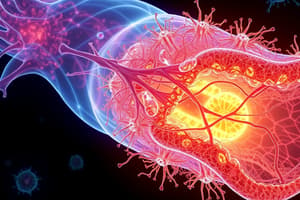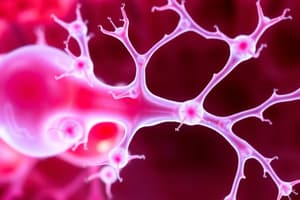Podcast
Questions and Answers
What primarily regulates the differentiation of neural cells during prenatal development?
What primarily regulates the differentiation of neural cells during prenatal development?
- Delta signaling
- Notch signaling (correct)
- Oligodendrocyte differentiation
- Astrocyte differentiation
Which signaling pathway promotes the generation of glial cells during post-natal development?
Which signaling pathway promotes the generation of glial cells during post-natal development?
- Notch signaling (correct)
- Delta signaling
- Numb regulation
- Proneural gene activation
What happens when Delta binds to Notch?
What happens when Delta binds to Notch?
- Formation of oligodendrocytes
- Translocation of the Notch domain into the nucleus (correct)
- Inhibition of transcription factors
- Activation of the achaete-scute gene
Which phase of cell differentiation peaks around the time of birth?
Which phase of cell differentiation peaks around the time of birth?
What role does the protein 'numb' play during cell differentiation?
What role does the protein 'numb' play during cell differentiation?
Which type of cells does Notch signaling favor in a developing neural context?
Which type of cells does Notch signaling favor in a developing neural context?
Which transcription factor is activated by the intracellular domain of Notch after Delta binding?
Which transcription factor is activated by the intracellular domain of Notch after Delta binding?
What is the primary function of oligodendrocytes in the nervous system?
What is the primary function of oligodendrocytes in the nervous system?
What happens to neurons that do not receive adequate neurotrophic factors?
What happens to neurons that do not receive adequate neurotrophic factors?
Which neurotransmitter is primarily used at neuromuscular junctions?
Which neurotransmitter is primarily used at neuromuscular junctions?
What role does acetylcholinesterase play in neuromuscular transmission?
What role does acetylcholinesterase play in neuromuscular transmission?
How does an action potential trigger the release of acetylcholine at the neuromuscular junction?
How does an action potential trigger the release of acetylcholine at the neuromuscular junction?
What is the function of the junctional folds on the sacrolemma of muscle fibers?
What is the function of the junctional folds on the sacrolemma of muscle fibers?
What role does the growth cone play in neuron maturation?
What role does the growth cone play in neuron maturation?
Which of the following accurately describes long-term potentiation?
Which of the following accurately describes long-term potentiation?
What initiates the formation of dendrites during neuron maturation?
What initiates the formation of dendrites during neuron maturation?
Which receptors are primarily involved in long-term potentiation?
Which receptors are primarily involved in long-term potentiation?
What is the role of lamellipodia and filopodia in neuronal growth?
What is the role of lamellipodia and filopodia in neuronal growth?
Which statement about synaptic plasticity is true?
Which statement about synaptic plasticity is true?
What outcome results when a synapse of one neuron repeatedly excites another neuron?
What outcome results when a synapse of one neuron repeatedly excites another neuron?
What distinguishes structural plasticity from synaptic plasticity?
What distinguishes structural plasticity from synaptic plasticity?
What is a structural similarity between central and peripheral nervous system synapses?
What is a structural similarity between central and peripheral nervous system synapses?
Which type of synapse lacks basal lamina?
Which type of synapse lacks basal lamina?
What neurotransmitter is primarily excitatory in the central nervous system?
What neurotransmitter is primarily excitatory in the central nervous system?
What is a key difference between neurotransmitter receptors in CNS and PNS?
What is a key difference between neurotransmitter receptors in CNS and PNS?
During which stage does the development of basic visual and auditory functions begin?
During which stage does the development of basic visual and auditory functions begin?
Which neurotransmitter is inhibitory in both the central and peripheral nervous systems?
Which neurotransmitter is inhibitory in both the central and peripheral nervous systems?
What happens to synapses during development according to this information?
What happens to synapses during development according to this information?
What structural feature is unique to peripheral nervous system synapses?
What structural feature is unique to peripheral nervous system synapses?
What characterizes the preoperational stage of cognitive development?
What characterizes the preoperational stage of cognitive development?
At what age range does the concrete operational stage of cognitive development occur?
At what age range does the concrete operational stage of cognitive development occur?
Which neural process refers to the degradation of the axon and loss of function in neighboring cells following an injury?
Which neural process refers to the degradation of the axon and loss of function in neighboring cells following an injury?
What role do oligodendrocytes and Schwann cells play following axonal damage?
What role do oligodendrocytes and Schwann cells play following axonal damage?
What significant change occurs in the prefrontal cortex during the formal operational stage?
What significant change occurs in the prefrontal cortex during the formal operational stage?
What is a major characteristic of the formal operation stage in cognitive development?
What is a major characteristic of the formal operation stage in cognitive development?
What triggers local inflammation following axonal injury?
What triggers local inflammation following axonal injury?
Which statement about synapse pruning is true?
Which statement about synapse pruning is true?
Flashcards are hidden until you start studying
Study Notes
Cell Differentiation
- Neural differentiation occurs primarily prenatally, astrocyte differentiation peaks around birth, and oligodendrocyte differentiation is the third phase.
- Notch signaling plays a crucial role in cell differentiation. Notch is a cell surface receptor that, when bound by Delta, triggers a cascade that ultimately activates transcription factors.
- Prenatally, Notch promotes self-renewal of developing stem cells.
- Postnatally, Notch promotes glial cell generation.
- The "suppressor of hairless" transcription factor, activated by Notch signaling, inhibits "achaete-scute" gene expression leading to a decrease in Delta expression, ultimately determining cell fate.
- The protein Numb, localized to one daughter cell after cell division, prevents Notch signaling in that cell, ensuring one daughter cell becomes a neuron and the other a glial cell.
Synaptic Plasticity
- Growth cones, at the tip of neurites, are complex structures crucial for finding appropriate targets for neuronal connections.
- Growth cones extend lamellipodia and filopodia, searching for targets.
- Once a target is found, neurites form, with one becoming the axon and the others becoming dendrites.
- Synaptic plasticity refers to the ability of synapses to strengthen or weaken over time, key for learning and memory.
- Potentiation strengthens synapses, while depression weakens them.
- Neurotrophic factors, like nerve growth factor (NGF), play a role in neuronal survival and synaptic plasticity. They signal through receptors like TRKA, inducing changes in gene expression.
- Long-term potentiation (LTP) is a form of synaptic strengthening that involves AMPA and NMDA receptors, both activated by glutamate.
- AMPA receptor activation allows Na+ influx, while NMDA receptor activation leads to Ca2+ influx, triggering a cascade of processes that ultimately strengthen the synapse.
Central vs. Peripheral Nervous Systems
- Central and peripheral synapses share structural similarities but differ in their neurotransmitter systems.
- Glutamate is the primary excitatory neurotransmitter in the CNS, while acetylcholine is the primary excitatory neurotransmitter in the PNS.
- GABA and glycine are inhibitory neurotransmitters in the CNS, while GABA is an inhibitory neurotransmitter in the PNS.
Development of Neurogenesis in Stages
- Sensorimotor stage (birth to 2 years) involves the development of basic motor skills, linked to the formation of synapses in visual (occipital lobe) and auditory (temporal lobe) cortices.
- Preoperational stage (2-7 years) is characterized by the development of symbolic thought and language, connected to the formation of synapses in the angular gyrus (parietal lobe) and Broca's area (frontal lobe).
- Concrete Operational stage (7-11 years) sees the development of logical thinking and conservation concepts, attributed to the formation of synapses in the prefrontal cortex.
- Formal Operational stage (12 years onwards) involves advanced reasoning and complex problem-solving, attributed to the maturation of the prefrontal cortex, which can take until the age of 25.
Regeneration and Damage in the Nervous System
- Axons, being long and vulnerable, are often the site of damage in the nervous system.
- Axotomy, or axon damage, triggers Wallerian degradation, a process that results in degeneration of the axon and its synapses.
- Myelin sheaths are also affected by axotomy, leading to oligodendrocyte/Schwann cell degeneration and inflammation.
- Macrophages, neutrophils, and glial cells form a glial scar at the site of injury.
- Regeneration is possible in the peripheral nervous system (PNS), where Schwann cells help guide axonal regrowth.
- However, regeneration is limited in the central nervous system (CNS) due to factors like the formation of glial scars and the absence of the same supporting cells found in the PNS.
Studying That Suits You
Use AI to generate personalized quizzes and flashcards to suit your learning preferences.




